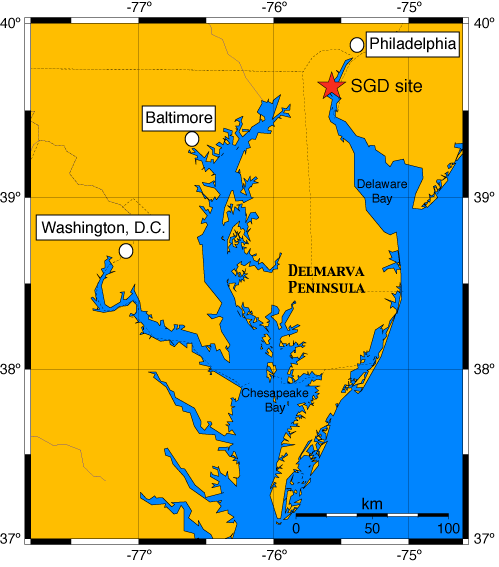


 |  |  | 5.4 Nutrient Fluxes from Submarine Groundwater Discharge |
The nature of chemical tracers of groundwater discharge underscores the fundamental issue of SGD vis-ˆ-vis nutrient fluxes: groundwater chemistry differs from surface water chemistry. Therefore, groundwater discharge to surface waters can alter the chemistry (and, by extension, the biogeochemistry) of the receiving waters in the coastal zone.
Surface water discharge to the coastal zone undergoes physical and biogeochemical processing via the estuarine filter (Kennedy, 1984), within which particle precipitation, geochemical transformation, and biological uptake alter the water chemistry such that the water that leaves the estuary is different from that which enters the estuary as fluvial discharge. Submarine groundwater discharge bypasses the estuarine filter, though there is evidence that the groundwater discharge is geochemically altered via passage through a `subterranean estuary' [362][79]. Where aquifer chemistry has been affected by anthropogenic activities (e.g., infiltration of fertilizers and agricultural runoff), inorganic nutrients may be transported with groundwater, bypassing the estuarine filter to be transported (more or less) directly into receiving waters.
Using excess 222Rn as a groundwater tracer in the Delaware Estuary, Schwartz [408] calculated a groundwater flux of 14.5-29.3 m3 s-1, equivalent to the discharge of the Schuylkill and Brandywine Rivers, the second and third largest tributaries to the Delaware River and Bay. This discharge occurred along 12 km of the estuary and is equal to an upward flow velocity of 5-10 cm d-1.
Agriculture, including crop and chicken farming, is a major industry on the Delmarva Peninsula, a broad coastal plain peninsula located near several major urban centers and separating the Chesapeake Bay and the Delaware Bay (Figure 4).

Two aquifers are hydraulically connected to the surficial aquifer in the vicinity of the Delaware SGD site. These units were identified by reviewing stratigraphic maps of the underlying geology of the Delmarva Peninsula and appear to be the source of the groundwater discharge [408]. The geochemistry of these source aquifers has been affected by agricultural activities and groundwater nitrate concentrations are as high as 1,000 µM [29]. Nitrate is a potential nutrient for both heterotrophic and autotrophic organisms in the estuary.
The groundwater-mediated nitrate flux to the Delaware SGD zone was calculated by multiplying the groundwater flux rate by the average nitrate concentrations in the two source aquifers (175 µM); this resulted in a groundwater nitrate flux of 2.5-5.1 moles s-1. The groundwater nitrate flux compares favorably to non-point source and fluvial nitrate sources to the Delaware Estuary (Table 1).
|
Delaware Estuary Nitrate Source | Nitrate flux | SGD Nitrate Flux as | Citation |
| [moles s-1] | Percentage of Cited Flux | ||
| SGD | 2.5-5.1 | N/A | [407] |
| Wet atmospheric deposition | 7 | 36-73% | [410] |
| Municipal industrial effluent | 16 | 16-32% | [410] |
| 14 Major municipal and sewage | |||
| effluents, combined | 7.1 | 35-72% | [159] |
| Delaware R. at Trenton | 18 | 14-28% | [410] |
| Delaware R. at Trenton | 20.7 | 12-25% | [159] |
| Delaware River at S=0 | 55 | 5-9% | [410] |
| Schuylkill River | 14.7 | 17-35% | [159] |
| Lower Delaware Bay tributaries, | |||
| combined | 8 | 31-64% | [410] |
While assessing global new-nitrogen fluxes to the coastal ocean, Paerl [362] observed that "parallel estimates for groundwater-nitrogen inputs into these [coastal] waters ...indicate a growing budgetary role for this nitrogen source, ranging from <10 to 30% of the new nitrogen inputs." This same study estimated that SGD to the coastal ocean accounts for 5-10 Tg N y-1; this value is up to one-third that of the coastal ocean new-nitrogen loading by both atmospheric deposition (ca. 35 Tg N y-1) and the combined effect of fluvial discharge and surface runoff (30 Tg N y-1). Both the aforementioned case study and the results summarized above certainly suggest that the `growing budgetary role' ascribed to groundwater nutrient fluxes by Paerl [362] may yet increase as additional studies are undertaken.
Several SGD assessments were performed throughout the eastern USA over the past 25 years. Though this SGD research constitutes only a fraction of the studies on surface water impacts on estuarine and coastal biogeochemistry, many studies have revealed that the biogeochemical impact of SGD can be important both locally and regionally. These studies have determined the flux of dissolved nutrients, including nitrate, phosphate, the dissolved inorganic nitrogen (DIN), and dissolved inorganic phosphate (DIP). Some notable research into SGD nutrient fluxes to the coastal zone include:
As a comparison, the Delaware SGD nitrate flux, above, is equivalent to 3300-6700 mmol N m-2 y-1 throughout the groundwater discharge zone.
 |  |  | 5.4 Nutrient Fluxes from Submarine Groundwater Discharge |